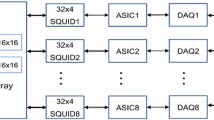Abstract
Microwave kinetic inductance detectors (MKIDs) are promising for THz direct detector arrays of large size, particularly with simple frequency-division multiplexing. Purple Mountain Observatory is developing a terahertz superconducting imaging array (TeSIA) for the DATE5 telescope to be constructed at Dome A, Antarctica. Here we report on the development of a prototype array for the TeSIA, namely an \(8\times 8\) CPW MKID array at 0.35 THz. The resonance frequencies of the MKIDs span the 4–5.575 GHz band with an interval of 25 MHz. Each detector is integrated with a twin-slot antenna centered at 0.5 THz and with a relative bandwidth of 10 %, while the whole MKID array with a micro-lens array. Detailed design and measurement results will be presented.
Similar content being viewed by others
Avoid common mistakes on your manuscript.
1 Introduction
China is planning to construct an observatory at Dome A, Antarctica, which has been found to be an excellent site (with low precipitable water vapor and low atmospheric boundary layer) on the earth for THz and Optical/IR astronomy. The 5-m THz telescope (DATE5 [1]), mainly targeting at the 350 and 200 \(\upmu \)m atmospheric windows, is one of the two telescopes to be built there. A science case for the DATE5 is to observe extreme starburst galaxies at different redshifts to better understand the nature and evolution of these enigmatic and important objects. To meet this requirement, a superconducting imaging camera named TeSIA is proposed [2]. TeSIA operating at 350 \(\upmu \)m has an array size of \(32\times 32\) pixels and requires a background-limited sensitivity as high as 10\(^{-16}\) W/Hz\(^{0.5}\). A long-wavelength (850 \(\upmu \)m or 0.35 THz) prototype with a smaller size of \(8\times 8\) pixels is being developed with both transition edge sensor (TES) and microwave kinetic inductance detectors (MKIDs) [3]. Here we mainly report on the development of an \(8\times 8\) CPW MKID array at 0.35 THz.
As is well known, microwave kinetic inductance detectors (MKIDs) use frequency-domain multiplexing (FDM) that allows thousands of pixels to be read out over a single microwave transmission line followed by a cryogenically cooled low-noise amplifier [4]. In addition, a large number of MKIDs can be integrated with a filter bank to realize on-chip spectrometers such as DESHIMA and SuperSpec [5, 6]. The MKID array we are developing makes use of TiN superconducting films [7] with a critical temperature of approximately 4.5 K. Such a superconducting film is just suitable for both the operating temperature of 0.3 K and the frequency of 0.35 THz for our \(8\times 8\) CPW MKID array. The \(8\times 8\) TiN MKID array will be integrated with an \(8\times 8\) micro-lens array of 0.95-mm-diameter hyper-spherical Si lens. The FDM readout for this MKID array is similar to those used by other groups, but makes use of a commercial arbitrary wave-function generator to generate 64-tone input signal with 45-dB SNR.
2 MKID Design and Fabrication
We adopted the coplanar-waveguide (CPW) type resonator to design our \(8\times 8\) TiN MKID array because it has a relatively simple architecture of only one thin-film layer on the substrate. This kind of resonator has a quarter-wavelength transmission line with one end capacitively coupled to a microwave feed line and the other matched to a planar antenna (twin-slot antenna, for example) [8]. Figure 1 shows the overall view of a fabricated MKIDs that consist of a coupler, a resonator, and a planar antenna, as well as the enlarged parts of the coupler and the antenna.
We first designed the coupler, which is an elbow structure at the end of the resonator near the microwave feed line, just as shown in Fig. 1. With this layout, the feed line and the coupler share the same metal section as the ground. The CPW feed line was designed to have a 10 \(\upmu \)m center strip width and 6 \(\upmu \)m gaps, corresponding to a characteristic impedance of 50 \(\Omega \). The CPW line for the coupler was designed to have a 3 \(\upmu \)m center stripe and 2 \(\upmu \)m gaps. The ground space between the feed line and the coupler was set at 2 \(\upmu \)m. Based on this structure, we can have different coupling strength by changing the coupler length only. Using an electromagnetic microwave simulator [9], we simulated the dependences of the coupling strength upon the coupling quality factor (\(Q_\mathrm{c}\)), the resonance frequency (\(f_{0}\)), and the coupler length (\(L_\mathrm{c}\)). As is well known, \(Q_\mathrm{c}\) can be calculated directly from \(S_{13}\), i.e., the transmission from the feed line to the coupler, according to \(Q_\mathrm{c} ={\pi }/2\left| {\text{ S }_{13}} \right| ^2\) [10]. Note that our simulations cover a resonance frequency range from 3 to 7 GHz and \(L_\mathrm{c}\) from 5 to 1005 \(\upmu \)m, and that the metal film is assumed to be lossless. The designed \(8\times 8\) TiN MKIDs have coupling quality factors ranging from 50 to 1000 k and resonance frequencies between 4 and 5.575 GHz with an interval of 25 MHz. The lengths of the resonators were calculated straightforwardly according to an effective quarter-wavelength with zero penetration depth. The twin-slot antenna was designed simply at a center frequency of 0.35 THz and with a relative bandwidth of 10 %. Note that the impact of the high resistivity of TiN films will be taken into account for further simulation.
The \(8\times 8\) MKID array was fabricated in the clean room of RIKEN Center for Advanced Photonics (Japan). As introduced before, we chose TiN superconducting films for this MKID detector array [11]. Its \(T_\mathrm{c}\) can be controlled between 0 and 5 K by the components of Ti and N\(_{2}\) [7]. Firstly, a 100-nm-thick TiN film was deposited on a high resistivity Si wafer in a DC magnetron sputtering system. Secondly, the CPW lines were defined in contact lithography by a mask aligner. Thirdly, the etching course was done in an ICP machine. The details of the process are summarized in Table 1. The fabricated MKIDs, as shown in Fig. 1, have a \(T_\mathrm{c}\) approximately equal to 4.5 K.
3 Measured Performances
For the fabricated \(8\times 8\) TiN MKID array, we mainly measured the dependence of its transmission characteristic and the Q factors of the resonators upon the bath temperature. Our measurements were carried out simply by using a scalar network analyzer to the \(8\times 8\) TiN MKID array followed by a 0.1–12 GHz cryogenically cooled low-noise amplifier, which has an equivalent noise temperature of 5 K and a gain of approximately 35 dB. The \(8\times 8\) TiN MKID array was cooled by an Oxford \(^{3}\)He/\(^{4}\)He dilution refrigerator down to 22 mK.
The transmission characteristic of the \(8\times 8\) TiN MKID array was firstly measured in a frequency range of 0.5–9.5 GHz at different temperatures. Figure 2 shows the measured \(S_{21}\) of the \(8\times 8\) TiN MKIDs at 22 mK from 3.3 to 4.8 GHz, where 64 resonance dips are located. Also shown in Fig. 2 is the distribution of the 64 resonance frequencies. Obviously the baseline ripple is caused by long microwave cables. It can be clearly seen that the resonance frequencies are shifted to lower values than the designed ones, while their intervals are fairly close to the designed value. The frequency shift is mainly due to considerable kinetic inductance of TiN films. According to the difference between the designed and measured resonance frequencies, the fractional ratio of the kinetic inductance is about 0.3. It is worthwhile to point out that we observed a sharp change of the transmission characteristic at about 4.5 K, which is in good agreement with the measured superconducting film \(T_\mathrm{c}\).
We then fitted the \(S_{21}\) results measured at different temperatures based on nine parameter model [10]. The internal Q factors of about half the MKIDs are higher than 100k, while the others are above 10k. The measured internal Q factors are obviously lower than the designed values. We think the TiN film quality needs to be further improved. We plot here the resonance-frequency shift with bath temperature for the resonator with a resonance frequency of 4.26 GHz at 22 mK. A theoretical curve of the Mattis–Bardeen theory [12] is plotted for comparison. Obviously, our result demonstrates a lower roll-off. We think the Dynes density of states (DOS) [13], instead of the simple BCS DOS, should be taken into account for fitting the result shown in Fig. 3. The difference of superconducting film quality can be distinguished, particularly for those of high resistivity.
Resonance-frequency shift as a function of the bath temperature normalized to \(T_\mathrm{c}\). A theoretical curve of the Mattis–Bardeen theory [12] is plotted for comparison (Color figure online)
4 Conclusion
We have designed and fabricated a 0.35-THz \(8\times 8\) CPW MKID array based on TiN superconducting films of \(T_\mathrm{c}\) equal to 4.5 K. Its transmission characteristic has been measured at different bath temperatures. We have found that the Q factors of the MKIDs measured at 22 mK range from 10 to 100 k. The frequency shift with respect to the normalized bath temperature (T/\(T_\mathrm{c})\) follows a general trend predicted by the Mattis–Bardeen theory, but with a lower roll-off.
References
J. Yang et al., Res. Astron. Astrophys. 13(12), 1493 (2013)
S.C. Shi et al., J. Low Temp. Phys. (2015). doi:10.1007/s10909-015-1355-1
P.K. Day et al., Nature 425, 817 (2003)
J. Baselmans, LTD-14 JLTP (2014)
A. Endo et al., in Millimeter, Submillimeter, and Far-Infrared Detectors and Instrumentation for Astronomy VI, vol. 8452, ed. by W.S. Holland, J. Zmuidzinas, Proceedings of SPIE (2012). doi:10.1117/12.925637
E. Shirokoff et al., in Millimeter, Submillimeter, and Far-Infrared Detectors and Instrumentation for Astronomy VI, Proceedings SPIE 8452, vol. 84520R (2012). doi:10.1117/12.927070
H.G. Leduc et al., App. Phys. Lett. 97, 102509 (2010)
J.J.A. Baselmans et al., Proceedings of the 7th International Workshop on LTE (2006)
Sonnet Suits, High Frequency Electromagnetic Software, 100 Elwood Davis Road North Syracuse, NY 13212
B.A. Mazin, PhD thesis (2004)
K. Koga et al., in The 23th International Symposium on Space Terahertz Technology (2012)
D.C. Mattis et al., Phys. Rev. 111, 412 (1958)
R.C. Dynes et al., Phys. Rev. Lett. 41, 1509 (1978)
Acknowledgments
This work was supported in part by the National Natural Science Foundation of China under Grant Nos. 11127903 and 11422326, and by Chinese Academy of Sciences under the Strategic Priority Research Program XDB04010300.
Author information
Authors and Affiliations
Corresponding author
Rights and permissions
Open Access This article is distributed under the terms of the Creative Commons Attribution 4.0 International License (http://creativecommons.org/licenses/by/4.0/), which permits unrestricted use, distribution, and reproduction in any medium, provided you give appropriate credit to the original author(s) and the source, provide a link to the Creative Commons license, and indicate if changes were made.
About this article
Cite this article
Li, J., Yang, JP., Lin, ZH. et al. Development of an \(8\times 8\) CPW Microwave Kinetic Inductance Detector (MKID) Array at 0.35 THz. J Low Temp Phys 184, 103–107 (2016). https://doi.org/10.1007/s10909-015-1382-y
Received:
Accepted:
Published:
Issue Date:
DOI: https://doi.org/10.1007/s10909-015-1382-y







